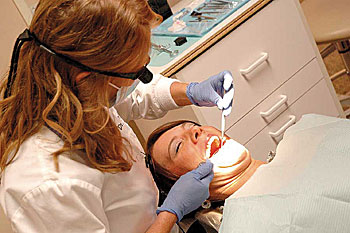Here’s what happened next. See if you can find the tips.

The assistant put the vacuum in. My dentist pulled my lip away and said, “You’ll feel a slight prick”, which I did. 15 seconds passed and she was still holding the needle in my gum. Several deep breaths; still the needle remained. Thirty seconds passed; still in there. I raised my hands and made the universal “this is lasting over a long time” gesture – you know the one, put your hands together, fingertips touching and pull your hands apart slowly.
“Yes,” she said, acknowledging my gesture and STILL holding the needle in place. Thirty more seconds. One more deeper breath: finally, out it came.
Now I could talk:
“Wow, that seemed like a really long time. I would have liked to have known up front that it would be a long time.”
“I do that so it won’t hurt as much.”
“Thank you. It didn’t hurt at all. I would have liked to know up front that it would be a long time.”
“Thanks for the feedback. Some patients don’t want to know anything, the don’t-talk-to-me-until-it’s-over folks.”
“I like to know.”
“You got it.”
Did you find the tips?
Tip #2: Acknowledge the feedback. (I repeated my comment because I didn’t feel heard. When she said “thank you for your feedback,” the communication loop was closed.)
There are a couple more tips in this short exchange.
Tip #3: Watch and read body language. (My hand signals.)
Tip #4: Don’t deflect or diminish someone’s experience or point of view. My dentist did not say: “Oh, it was only in there 20 seconds total. That’s not long.”
Numb gum. Sensitive ears.
With my gum numb, she began drilling (I hate that high-pitched screech!) and narrating the requested play-by-play. She used wedges, a metal corral (my word), laser light to reveal the crack and cure the various compounds. Rinse. Spit. All done.
My tooth was always going to be fixed. What made me feel great as I left (Ok, leaving the dentist is always better than going in. Am I right?), was my experience of being heard and respected.
When my dentist thanked me for my feedback, she took the concern right out of my mouth — the concern that she didn’t care about what I needed and wanted.
Good news: You don’t have to go to the dentist to use these tips. Experiment with them in your very next conversation. This goes for everyone: Leaders, Employees, Executive Directors, Volunteers. Deliver your information in a style that makes it easy for your listener to hear. When you do, you’ll be seen as someone who proactively fills the cracks of misunderstanding before they cause damage.
Take care!